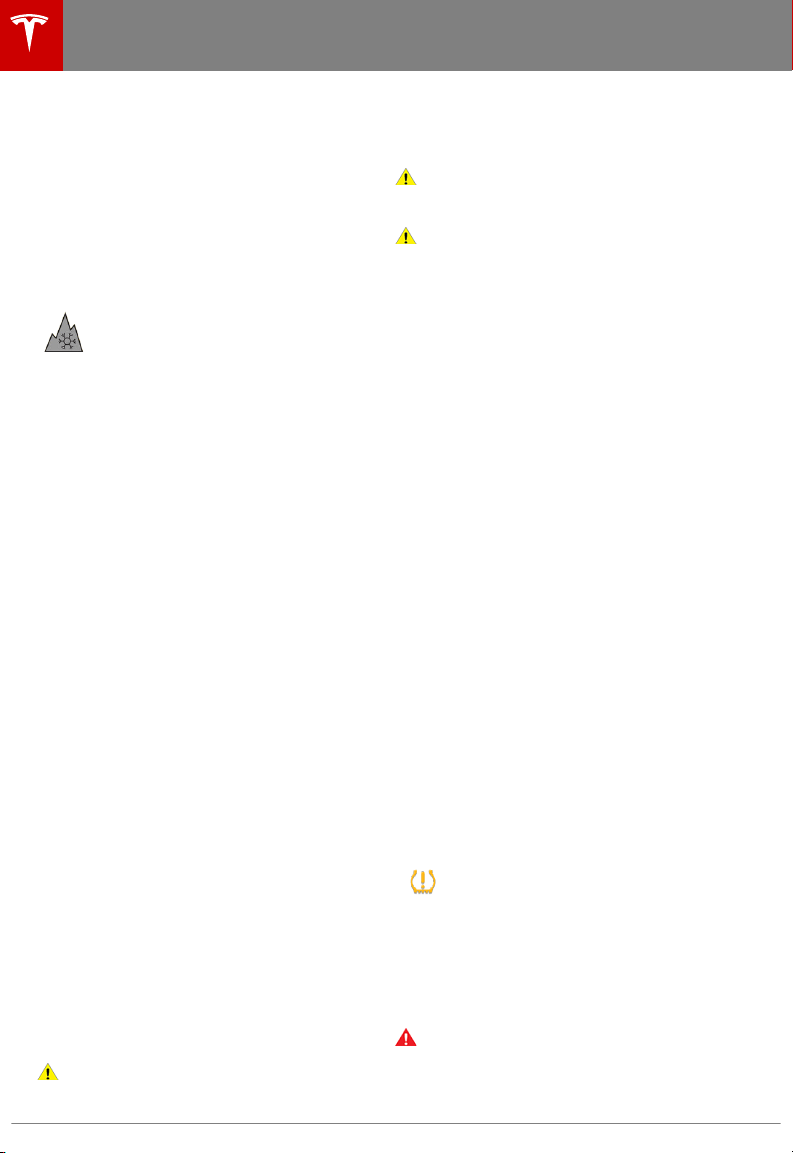Loading ...
Loading ...
Loading ...

Winter Tires
Your Model X is not originally equipped with
winter tires. To increase traction in snowy or
icy conditions, consider installing winter tires.
When installing winter tires, always install a
complete set of four tires at the same time.
Winter tires must be the same size, brand,
construction and tread pattern on all four
wheels. Contact Tesla for winter tire
recommendations.
Winter tires can be identified by a
mountain/snowflake symbol on the
tire's sidewall.
When driving with winter tires, you may
experience more road noise, shorter tread life,
and less traction on dry roads.
Driving in Low Temperatures
Tire performance is reduced in low ambient
temperatures, resulting in reduced grip and an
increased susceptibility to damage from
impacts. Performance tires can temporarily
harden when cold, causing you to hear
rotational noise for the
first few km until the
tires warm up.
Using Tire Chains
Tesla has tested and approved Maggie Group
Trak Special LT51 snow chains to increase
traction in snowy conditions. These chains
must only be installed on rear 19 or 20" tires.
Do not use chains on 22" tires or on front tires.
The approved snow chains can be purchased
from Tesla.
When installing tire chains, follow the
instructions provided by the tire chain
manufacturer. Mount them as tightly as
possible.
When using tire chains:
• Drive slowly. Do not exceed 48 km/h.
• Avoid heavily loading Model X (heavy
loads can reduce the clearance between
the tires and the body).
• Remove the tire chains as soon as
conditions allow.
Note: Tire chains are prohibited in some
jurisdictions. Check local laws before installing
tire chains.
Caution: Using non-recommended tire
chains, or using tire chains on other sized
tires, can damage the suspension, body,
wheels, and/or brake lines. Damage
caused by using non-recommended tire
chains is not covered by the warranty.
Caution: Do not use chains on a Model X
equipped with 22" tires and do not use
tire chains on front tires.
Caution: Ensure that tire chains cannot
touch suspension components or brake
lines. If you hear the chains making
unusual noises that would indicate
contact with Model X, stop and
investigate immediately.
Tire Pressure Monitoring
Each tire should be checked monthly when
cold and inflated to the recommended
pressures that are printed on the Tire and
Loading Information label located on the
driver’s door pillar (see Maintaining Tire
Pressures on page 133). If your vehicle has
tires of a
dierent size than the size indicated
on the vehicle placard or tire
inflation pressure
label, determine the proper tire inflation
pressure for those tires.
As an added safety feature, your vehicle has
been equipped with a tire pressure monitoring
system (TPMS) that displays a tire pressure
telltale (Tire Pressure Warning) on the
instrument panel when one or more of your
tires is
significantly under- or over-inflated.
Accordingly, when the Tire Pressure indicator
light displays on the instrument panel to alert
you about tire pressure, stop and check your
tires as soon as possible, and
inflate them to
the proper pressure (see Maintaining Tire
Pressures on page 133). Driving on a
significantly under-inflated tire causes the tire
to overheat and can lead to tire failure.
Under-
inflation also reduces fuel eciency and tire
tread life, and may
aect the vehicle's
handling and stopping ability.
If Model X detects a fault with the
Tire Pressure Monitoring System
(TPMS), this indicator flashes for one
minute whenever you power on
Model X.
Note: Installing accessories that are not
approved by Tesla can interfere with the
TPMS.
Warning: The TPMS is not a substitute for
proper tire maintenance, including
manually checking tire pressures and
regularly inspecting the condition of tires.
It is the driver's responsibility to maintain
Tire Care and Maintenance
136 Model X Owner's Manual
Loading ...
Loading ...
Loading ...